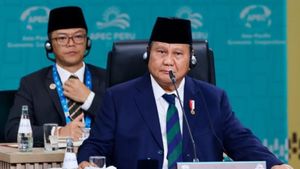JAKARTA - Today 267 years ago, or February 13, 1755 to be exact, the Giyanti Agreement was signed. The signing of the Giyanti Agreement was the origin of the split of the Islamic Mataram Kingdom into two: the Surakarta and Yogyakarta kingdoms. The Dutch trading company, VOC was behind it. All because the VOC played its popular word: Divide at Impera (division politics).
The Dutch trading company VOC once had a great feud with the Mataram kingdom. Both of them even had time to fight in 1628-1629 in Batavia. At that time, the power of Mataram, which was famous as the ruler of Java, was successfully tamed by the VOC.
However, the war actually made the VOC aware of various things. Including war makes them realize that the cost of war is too big. VOC brainstorming. The Devide at Impera strategy is once again the trick rather than the war option. The decision was effectual because the VOC could thrive because of it. Including in taming Mataram.

The VOC even dared to mediate in the conflict between the three potential heirs to the throne of the Mataram Kingdom. Prince Pakubuwono III, Prince Mangkubumi, and Raden Mas Said or Prince Sambernyawa. In it, the VOC tried to persuade Prince Pakubuwono II to want to share his territory with Prince Mangkubumi.
The division was legitimized by an agreement. The name Giyanti Agreement. An agreement that not only made Mataram split into two -- Surakarta and Yogyakarta -- but also reduced Mataram's chances of growing as big as before. The agreement was witnessed by the parties themselves. The VOC was represented by Nicolas Hartingh, Prince Pakubuwono III, and Prince Mangkubumi.
“In 1755, Hamengkubuwono I (Prince Mangkubumi) moved to Yogya. He built a palace there in 1756, and gave the city a new name, Yogyakarta. However, the new sultan faced formidable obstacles. There was still another king in Surakarta, Pakubuwono III. The problems arising from the presence of two kings, because the Javanese theory of legitimacy was based on the rule of only one king with supernatural powers, could not be solved for decades.”

“Presumably, Hamengkubuwono I thought that Pakubuwono II would not last long, because in 1755 almost no one in Surakarta's rulers supported him. However, after the Giyanti Agreement, many royal officials, who had previously fled the palace, returned to Surakarta. For the first time, Pakubuwono III became a fierce rival in seeking the support of the elite. This started the permanent atmosphere of the separation of the two palaces,” concluded historian MC Ricklefs in the book History of Modern Indonesia 1200-2004 (2005).
*Read other information about HISTORY or read other interesting articles from Detha Arya Tifada.
The English, Chinese, Japanese, Arabic, and French versions are automatically generated by the AI. So there may still be inaccuracies in translating, please always see Indonesian as our main language. (system supported by DigitalSiber.id)












